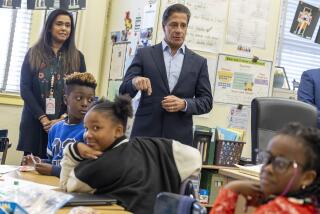Longer School Year Idea Faces Test
- Share via
SACRAMENTO — Gov. Gray Davis’ proposal to extend the California middle school year for more than 1 million students faces another tough test this week in the Capitol.
Unconvinced that more time in the classroom is the best way to improve student performance, some lawmakers appear ready to flunk Davis’ plan.
Sen. John Vasconcellos, the Santa Clara Democrat who chairs the Senate Education Committee, said he does not plan to vote for the proposal, which is scheduled to be taken up Wednesday in his committee. Vasconcellos favors instead an increase in spending on low-performing students, whom he likes to call California’s “unrealized learners.”
“The money ought to go where the kids have the most need,” Vasconcellos said.
Committee members Sen. Dede Alpert (D-San Diego) and Sen. Deborah Ortiz (D-Sacramento) said they doubt they will cast votes in favor of the proposal, despite a recent decision by the Davis administration to cut the extension from six weeks to four and dedicate millions of dollars to low-performing schools.
“Even given some improvement, I’m not comfortable with the proposal at this point,” Ortiz said.
Extending the middle school year was one of the flashiest ideas Davis floated in January when he unveiled his proposed budget. But it has met a chilly reception from the Legislature, the powerful California Teachers Assn. and the state’s independent legislative analyst, Elizabeth Hill.
Lawmakers, including Vasconcellos, have unleashed a slew of measures this year to help struggling students by attracting better teachers to low-performing schools and boosting parent involvement. Vasconcellos said he worries that students who are performing well in school will be robbed of rich life experiences by being forced to spend four extra weeks in class. He cited his granddaughter as an example.
“I don’t want her to lose enrichment,” he said.
It is difficult to prove that Davis’ proposal, embodied in SB 1020 by Sen. Martha Escutia (D-Whittier), would work, because it has been tested by so few schools in California or elsewhere.
“[Davis’ proposal] would be groundbreaking,” said Bruce Hunter, director of public policy for the American Assn. of School Administrators. “But that’s supposing that you don’t just stretch the same curriculum over more days.”
That wouldn’t be the case, said Kerry Mazzoni, Davis’ education secretary. Davis, she said, has proposed more training for school principals and professional development for teachers dealing with math and English.
Mazzoni said the optional plan, which is supported by the Los Angeles Unified School District, would help boost teacher salaries because the additional days would be accompanied by a commensurate pay increase. Zeroing in on middle school, she said, makes sense because it is when the foundation for high school is laid.
“Many teachers will say this is the last chance,” Mazzoni said. “This is where they either catch them or lose them.”
Middle school students in California for years have lagged behind their counterparts in elementary and high schools.
Policymakers in recent years have focused on the earliest grades for most of their reforms, including smaller class sizes and intensive instruction in reading.
Meanwhile, international comparisons have shown that U.S. students are performing worse than students in many industrialized nations. Some of those same studies indicated--erroneously--that U.S. students spend less time in school than those in countries that outperform them.
Some countries whose students do better than their U.S. counterparts in math and science actually have a shorter school year. In high-performing Sweden, for example, the school year is 170 days long, whereas the typical U.S. school year ranges from 175 to 180 days.
Still, many educators have surmised that one culprit for U.S. students’ underperformance is the traditional school calendar, which is rooted in an agrarian lifestyle that has all but disappeared.
The September-to-June calendar was crafted decades ago as a compromise between rural and urban communities to accommodate increasingly mobile families that demanded similar school programs as they moved throughout the country. And it has remained a mainstay, except in a few crowded urban areas, such as Los Angeles, that have had to resort to year-round scheduling to accommodate ballooning enrollments.
Yet educators have long raised concerns that many students lose academic ground over the long summer break. That is particularly true for students from low-income families, for those who do not speak English as a first language and for those with learning disabilities. Teachers, they maintain, must then spend valuable instruction time when school resumes reviewing forgotten math facts and spelling.
Despite concerns about “summer learning loss” and lack of competitiveness, few school districts have resorted to longer school years. An exception is Oxnard Union High School District in Ventura County.
Back in 1996, the 14,000-student, five-school district did not have the facilities or teachers to reduce class sizes. Extending the school year seemed the best way to affect as many students as possible.
The district launched a pilot program to provide more instructional time so teachers could go into subjects in greater depth. State funds paid for an additional 15 days, and the district came up with five more days by scheduling staff training outside regular school hours.
Foreshadowing many of the concerns that greeted the governor’s proposal, many teachers and parents complained that the program was too costly, that it would intrude on summer vacations and that it would prompt more students to drop out, said Gary Davis, the district’s assistant superintendent for educational services. But, lured by the promise of more pay, the teachers union agreed to the plan. It ran for four years before funding dried up.
The district liked the results. Studies showed that teachers spent more time developing topics in depth and giving students one-on-one help. Dropout rates decreased each year. And there were indications of improvements in student achievement, including gains in reading and math at the 11th-grade level, higher SAT scores and increased numbers of students taking Advanced Placement tests.
More to Read
Sign up for Essential California
The most important California stories and recommendations in your inbox every morning.
You may occasionally receive promotional content from the Los Angeles Times.














